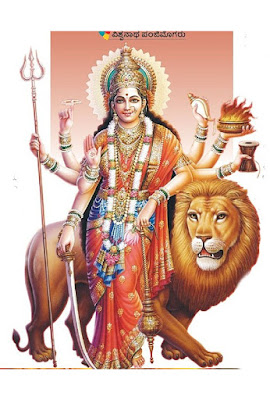|| devīstotrāṇi ||
sindhūrāruṇavigrahāṃ trinayanāṃ māṇikyamauḷisphurat
tārānāyakaśekharāṃ smitamukhīm āpīnavakṣorurhām |
pānibhyām alipūrṇaratnacaṣakāṃ raktotpalāṃ bibhratīṃ
saumyāṃ ratnaghaṭashtharaktacaraṇāṃ dhyāyet parām ambikām ||
śivaḥ ṣaktyā yukto yadi bhavati śaktaḥ prabhavitum
na cedevaṃ deva na kuśalaḥ spanditumapi |
atastvāmārādhyāṃ hariharaviriñcādibhirapi
praṇantuṃ stotuṃ vā kathamakṛtapuṇyaḥ prabhavati ||
Re-ordered word-by-word meaning
dhyāyet parāṃ ambikām - May one worship the Supreme Universal Mother, who is
sindhūrāruṇavigrahāṃ trinayanāṃ - of the reddish hue like the rising sun, with three eyes,
māṇikyamauḷisphurattārānāyakaśekharāṃ - wearing a gemstudded crown, shining with the crescent moon,
smitamukhīm āpīnavakṣorurhām - smiling faced, with full breasts,
pānibhyām bibhratīṃ - holding and displaying in her two hands,
alipūrṇaratnacaṣakāṃ raktotpalāṃ - a gem-studded goblet full of wine and a red lotus,
saumyāṃ ratnaghaṭashtharaktacaraṇāṃ - gentle, with her red-lotus like feet placed on a ruby-studded round stool.
yadi śivaḥ ṣaktyā yukto - If Shiva is united with Shakti=Devi,
bhavati śaktaḥ prabhavitum - He becomes capable of creating the world,
na cedevaṃ devaḥ na kuśalaḥ spanditumapi - not otherwise will He be capable even of moving himself, too.
atastvāmārādhyāṃ hariharaviriñcādibhirapi - Therefore, Oh Mother, You who are worshipped by Hari, Hara, and Brahma, too,
katham akṛtapuṇyaḥ praṇantuṃ stotuṃ vā prabhavati - how will a person who has not acquired merit/qualification through good deeds, be able to bow down to You or to pray to You?
These two shlokas are cardinal to Devi worship. The first is the Dhyana Shloka from Lalitha Sahasranama, a part of the Markandeya Purana. The second is the first shloka of Saundarya Lahari.
I have found Devi prayers to be full of colourful descriptions as well as expressions of exclusion and comparison of different deities. These are usual devices employed to increase one's faith and focus on one's Chosen Deity.
Happy Navaratri!
